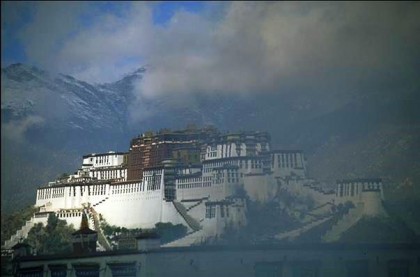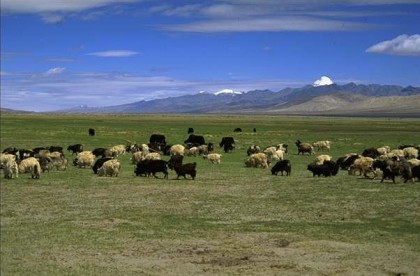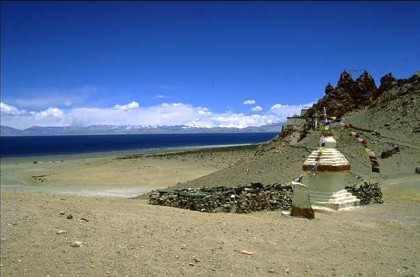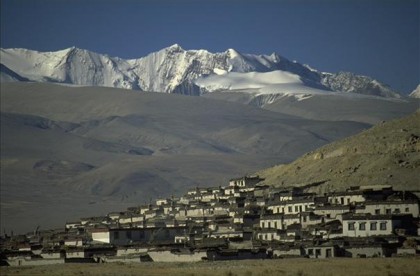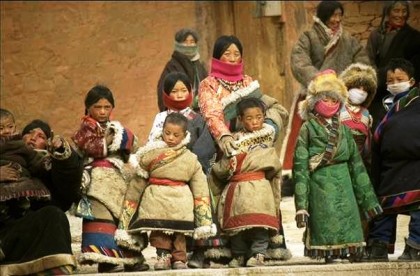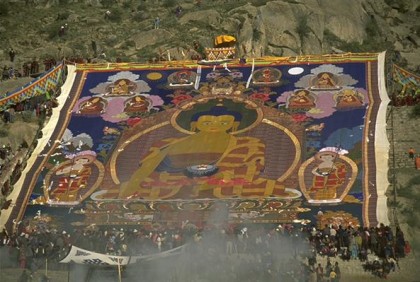
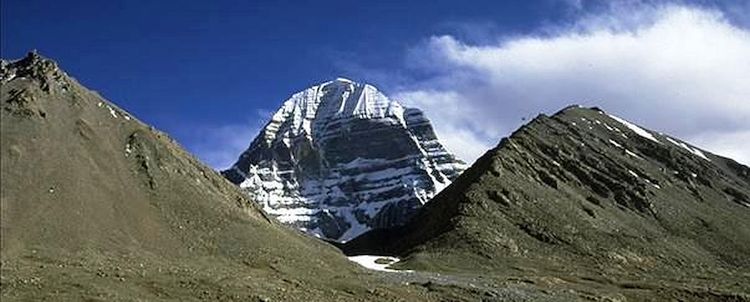
Tibet – Mysterious roof of the World
Best Travel Period | Tibet in Brief | Peoples and Religions | Food | Flora and Fauna | National Parks and Nature Reserves | Mountain Scenery and Trekking | History | Economy | Festival Calendar
Tibet belongs since centuries to the most fascinating countries on earth. Situated at 4000m altitude, the people living here learned to deal with the challenging climatic conditions through imperturbable serenity and the placid happiness of a simple life. For a long time, access to the "forbidden country" remained denied to travelers, until the invasion of Chinese troops in the late fifties changed this. The massive refugee flows of the locals at that time carried the millennia-old culture of life, and the teachings of Tibetan Buddhism first to India, then into the kingdom of Sikkim and to Nepal, where they found many new followers. While in Tibet itself then many religious institutions fell victim to the destructiveness of the Red Guards, blossomed the peaceful teachings in many places anew, and also formerly secret traditions were made available to a wide audience. The publication of a multitude of literature on Tibetan Buddhism caused a spread to the West, and makes one curious about the origin of this peaceful religion, and about the faithful, who live so happily according to their principles.
A trip to the seemingly endless mountain deserts, through barren, wide plateaus in the West, to dense, emerald green forests in the east of the country, the encounter with nomads, which are shaped by the weather, and their flocks of yaks, sheep and goats overwhelms every Himalaya traveler. Everywhere in Tibet the signs of the ancient faith are now visible again. The roofs of the houses, which are built of stamped earth, as it is typical for the country, as well as the numerous mountain passes, are decorated with colorful prayer flags. Buddhist pilgrims from all over the world travel today undisturbed to the sacred places like the mountains Kailash and Amnye Machen, the oracle lake and the oldest monastery in the country, Samye.The capital of the Autonomous Region of Tibet in particular, Lhasa, which also belongs to the holy sites of Tibetan Buddhism, attracts till today every day hundreds of pilgrims. The again lived faith lets destroyed temple sites arise anew, and fills them with joy, with venerable monks and young novices. The quiet smile that all these people wear on their lips, welcomes every visitor, and invites to participate in one of the numerous, colorful monastery or nomad festivals.
A visit to this legendary country, with competent accompaniment, offers certainly one of the most extraordinary travel experiences, which are possible on earth. Those who dear to defy the altitude and the dry climate, will feel the cold wind of history in the face, but also celebrate joyous festivals, and one experiences oneself and others in a clear purity such as never before - in short, on a trip to Tibet you will collect experiences, that are in no way inferior to the flora and fauna of the country in their many facets. To let your eyes wander over the arid high plateaus, lets peace and quiet flow into every human within minutes, and paves the way for unclouded joy and true happiness.
The mystery Tibet you can experience individually with us, by jeep, by bike, on horseback and on trekking trips on foot (www.yetilaya.com). We will advise you personally, so that you can build your bridge into this peaceful, multifaceted country completely according to your wishes!
Best Travel Period
Tibet is best experienced in the time of our summer and early autumn, from May to October. In the months of June, July and August, it is with temperatures around 20 ° C the warmest during the day (depending on the altitude much lower!), In July and August it can come to rains due to the monsoon, especially at night.
Tibet in Brief
| Location | In the southwest of the People's Republic of China, sharing southern borders with India, Nepal, Bhutan and Myanmar. |
| Area | 1,268,947 km² (autonomous region of Tibet) |
| Population | 3 million / 2.37 inhabitants per km² (2010) |
| Capital | Lhasa |
| Districts | 6 + 1 governmental districts (Lhasa City, Nagqu, Ngari, Nyingchi, Qamdo, Shannan and Xigazê) |
| Topography | Highland situated at an average of 4300 meters and surrounded by the Himalayas, Karakorum and Kunlun Mountains, crossed by other mountain ranges. More than 60 peaks with more than 7000 m, including Mount Everest - with 8848 meters the highest mountain in the world. |
| Vegetation | Exclusively alpine vegetation with coniferous and mixed forest areas in the east, mostly low-growing woody plants, mushrooms and herbs, as well as vast grasslands, which turn more and more into a desert due to climate change and intensive grazing. In remote areas can be found medicinal plants like notoginseng Panax pseudo ginseng, felwort Gentiana amarella or the shimmering Ganoderma Ganoderma lucidum, some of which are very rare, but partly due to large occurrences can even be exported. Often rocky ground, which is covered only by mosses and lichens, large gravel plains at the foot of the glacier. |
| Wildlife | In the higher elevations, among others Thorold’s deer and musk deer, antelope, kept to a not inconsiderable part as livestock are also sheep, goats, donkeys and yaks. In the valleys also leopards, tigers, lynx, bears, wolves, foxes, monkeys and birds such as black-naped cranes, bar-headed geese, seagulls, teals, Tibetan pheasant and grouse. |
| Climate | In Tibet prevails a dry highland climate, in which the temperature development throughout the year behaves similarly as in our latitudes. The months of June and July are the warmest ones, then March, April, May, August, September and October represent a transitional phase, before in November it is becoming cold until February. In July and August passes a weakened monsoon with its rainfalls over Tibet, snowfall is relatively rare, even in the lower elevations. |
| Temperatures | In the lower, southern regions it will be maximum 23 ° C warm in summer during the daytime, even in valleys which are further north and sheltered, values up to 20 ° C will be reached. The average temperature in these protected areas is at nearly 9 ° C, the national average is only around 0 ° C. Per 100 meters of altitude, the temperature decreases by about 0.5 ° C to 1 ° C, as soon as the sun is going down it will be very cold at any altitude. |
| Precipitation | The monsoon with its rainfall reaches Tibet only with low intensity due to the surrounding mountain ranges. Especially the north and the west are with less than 100 mm / m² very dry, in the other areas fall approximately 450 mm / m² of annual precipitation. |
| Languages | Han Chinese (high Chinese) and since 2002 also again the Tibetan language are equal official languages. |
| Ethnicties | In Tibet live about 15 different tribal communities, the vast majority are with over 90%, however, the Tibetans themselves. The next largest ethnic group are now the Han Chinese with about 6%, and there are further population parts which account for below 1%. |
| Religions | The original religion in Tibet is "Bön", a form of belief which is not dissimilar to Buddhism. Bön was replaced in a smooth transition by the Vajrayana Buddhism, which in turn has been divided into the four major schools Nyingma, Sakya, Kagyu and Gelugpa. On the part of the Chinese government, any religious practice in Tibet was suppressed for a long time, only since about the year 2000 is here - at least officially - a slow relaxation percieved. |
| Economy | Agriculture is still Tibet's main industry, although the meager soil allows almost exclusively the cultivation of highland barley and animal husbandry. Here most farmers travel as nomads with their herds from pasture to pasture. Because Tibet is a in mineral resources quite rich country, the government wants to promote the expansion of the mining industry; as well as tourism, which is to be promoted, and which in fact already has growth rates of 25% in recent years. |
| Getting there | By plane to Beijing or Shanghai, then connecting flight, usually with stopovers, to Lhasa, Shigatse and Nyingchi. By land or by airplane (Kathmandu - Lhasa) in combination with travel module Nepal. |
| Visa / Entry permit | A trip with identity card and passport, which must be valid six months more after the planned stay. In addition, a visa for China and a special permit for Tibet is required, and depending on the itinerary often more authorizations are necessary. The regulations for this are unfortunately being changed often. |
| Vaccinations | In addition to the usual immunizations, vaccinations against hepatitis, typhoid, Japanese encephalitis and rabies are recommended. |
Peoples and Religions
Of the total Tibetan population of about 3 million people, live about 80% in rural areas, 250,000 people in the capital Lhasa, and about 120,000 in the city Samzhubzê . Some 200,000 Tibetans still live up to today in exile in Bhutan, India, Nepal and the rest of the world. The Tibetans themselves also make by far the largest ethnic group in their country, only about 6% of the people living here are Chinese, with less than one percent are moreover still the national minorities of the Hui, Monba, Lhoba, Dengba, Sherpa, Naxi, Bai, Tami, Mongolians and Uyghurs represented. Almost all the ethnic groups are united in the religion of Buddhism, with a small proportion of Tibetans who are still practicing the original form of Bön, and the other Buddhists have joined one of the 4 schools Kagyu, Nyingma, Sakya and Gelupga.
After the Chinese government has suppressed any religious practice for a long time, there are according to official figures today about 46,000 Buddhist monks again, and 1,700 places where they can practice their religion. There are also four mosques for the about 3,000 Muslims living in Tibet, and a church for about 700 Catholics. The lives of the people in Tibet are dominated until today not only by the challenge of wringing a livelihood from the barren land, but also by the resistance to the oppression from the side of the Chinese government. Buddhism carries many of the people here through their everyday life, it is an immensely important part of their lives and, with its peaceful and serene attitude, the basis for the maintenance of independence and happiness.
Food
The diet of the Tibetan population is now slightly influenced by the Chinese cuisine, also Indian and Nepalese recipes and preparation methods have found their way into Tibet - which is mainly due to the food imports, which are unfortunately necessary to provide for the population. A special feature of the Tibetan cuisine is traditionally certainly the widespread consumption of yak meat, and the for religious reasons almost complete renunciation on poultry and fish. Otherwise, particularly the milk of yaks, sheep and goats is being processed, and provides animal protein. In the fertile valleys in eastern Tibet grow more diverse vegetable and fruit varieties, which however find their way less frequently into the highlands - here grows mainly highland barley, which then constitutes the staple food of the Tibetan population, in different and very tasty preparation forms, which are practical for long trips.
Flora and Fauna
In Tibet live in spite of the adverse climatic conditions more than 5,000 different plants of higher genera, and nearly 1000 species of vertebrates. The forests in the east are mainly composed of pines (Himalayan pine, Pinus yunnanensis, Pinus armandis), larch, spruce, fir (Abies spectabilis, hemlock fir), cypress and Chinese juniper. Because of partly excessive deforestation in the past, increasing reafforestation is taking place since several years, to prevent the further decrease of forested areas. Here in the forests live tigers, leopards (also the rare snow leopard was sighted at higher altitudes!), red pandas and monkeys, particularly in the grasslands one will find wild yaks, red and white-lipped deer, as well as antelopes, musk ox and - thanks to the large number of watercourses – otters.
In virtually all areas of Tibet spreads predominantly lower vegetation, consisting among others of more than 1000 species of wild herbs, of which about 400 are medicinal herbs, such as notoginseng Panax pseudo ginseng, the shimmering ganoderma Ganoderma lucidum and felwort Gentiana amarella. These medicinal herbs are partly growing in large numbers and belong to the export goods of Tibet. Wheat and highland barley (qingke barley) are being grown for agricultural use, and above all, in the southeast also grow rice, buckwheat, corn, sesame and peanuts. The number of mammals is complemented by nearly 600 species of birds (black-naped cranes, grouse and teals, but also rare species such as the crimson- bellied tragopan), some reptiles (the pythons are among the protected species) and more than 2000 different types of insects. The official, governmental nature reserves (Qomolangma and Medog) are supplemented by some areas with a hunting ban and farther going wildlife protection.
National Parks and Nature Reserves
The Chinese government has designated three areas as national parks, to these belongs since 2012 with the Qomolangma National Park the highest nature reserve in the world. The proud 78,000 km² large park terrain includes five eight-thousander summits, among them the Mount Everest, Mount Cho Oyo, as well Mount Shishapangma. Accordingly sparse is the vegetation of the region, however, some medically interesting and rare herbs can be found. The protection zone is especially important, since it prohibits the hunting of predators and other mammals, and so offers for example to the snow leopard a valuable retreat. Even the Nyainqentanglha National Park, which exists since 2009, protects the habitat of an unique mountain world, and is located in the about 700 km long mountain range bearing the same name.
In particular, these mountains of somewhat lower elevations, with a highest peak of 7090 m above sea level, offer to the last few snow leopards sufficiently large areas and, among others, because the very shy animals encounter here even fewer people, even promising stocks of prey in the form of wild sheep and goats of various types. Also protected since 2009 are the river valleys of the Yarlung and Salween, which stretch beyond the province borders of Tibet, and not only form an unimaginably large protected area, combined with other protection zones as "The three parallel rivers", but have been awarded the title of UNESCO World Heritage Site. However, really untouched areas can be found here mainly in the upper reaches of each river, further downstream has been encroached even here, for example by building dams into the original nature. However, the ban on hunting for rare mammals, birds and reptiles is valid throughout the zone.
Mountain Scenery and Trekking
For trekking fans with a good physical constitution, Tibet is an absolute dreamland. The mountain scenery is varied, and opens access to 7000 m and 8000 m high peaks, embedded in a fascinating landscape of mild high valleys, vast steppes, glaciers and scree slopes, which appear to be the ball game courts of giants. Also cave explorers will be fascinated. Those who are interested in Tibetan Buddhism will recognize through the many colorful prayer flags, which dance in the breeze here along the pilgrimage routes and mountain paths, that religion is traditionally more than a faith which is limited to Sundays and holidays for the people living here.
The peacefulness of Buddhism and the teachings of his deep-rooted respect for all life is here an indispensable philosophy of everyday life. Who is physically able to be at high altitudes (trekking routes start at approximately 3000 meters altitude) can experience mountain panoramas in Tibet, where ancient monasteries nestle onto rugged cliffs and snow-covered mountain giants form a picturesque backdrop. About the proven trekking routes we gladly advise you individually! On a somewhat lower elevation we can recommend a visit to the Yarlung River National Park, which is situated along the eponymous Yarlung river, it follows the Yalung- Zangbo river valley upstream, and includes among others the monastery Changzhug on its terrain.
| Physical challenge | Description and area of the trek | Maximum height | Duration | Type of accommodation | Notes / Description |
|---|---|---|---|---|---|
| demanding | Simikot - Mount Kailash | 2960 - 5630 meters | 21 days | tent | Trek through the remote Karnali river valley of western Nepal, then border crossing to Tibet. We discover 'GugeKingdom', one of the first Tibetan settlements and Mount Kailash, the holiest pilgrimage site in Tibet. |
| demanding | Everest Base camp | 3660 -6400 meters | 21 days | Mountain cabin & tent | Tibet is an untamed land of nomads (drokpas), of monasteries and elevation deserts in seemingly endless expansion. Along the "roof of the world" we discover a picturesque mosaic of Tibetan settlements, nomadic shepherds with their flocks, and ancient monasteries, we cross vast plains and high mountain passes and enjoy breathtaking mountain panoramas. |
History
In motion like the prayer flags, which are fluttering wildly in the wind everywhere in the mountains of Tibet, is also the country's history. Already since the 10th century AD and until the 1950s, Tibet was a kingdom, whose people could call free land ownership their own right - throughout all of Europe in the Middle Ages was this an unthinkable state, belonged here after all the whole land to the nobility or the church. The occupation by the Mongols in the 13th century was survived by the Tibetans fairly unscathed, their teachings of Buddhism have been indeed attacked, but ultimately had emerged strengthened, rather than weakened. In the year of 1578 the 1st Dalai Lama has been appointed by a Mongol prince as a sort of governor, whose successor then finally became the actual, highest a leader of the Tibetan statehood in 1642, and is it up to this day.
Today, however, the Dalai Lama as well as the other Tibetan government members live in exile, because after a short British occupation in the early 20th century, the Chinese took over power in 1951 in Tibet, and annexed the kingdom into their People's Republic. This status of the "Tibet Autonomous Region" as a part of China and also the actual frontiers are still controversial in international law, and are neither recognized by the Tibetan population, nor by the government in exile, and also not by some countries worldwide. Since then it comes to unrest in the country time and again, and even if the Dalai Lama calls his people to peaceful behavior according to the beliefs of Buddhism, people nevertheless defend themselves against the strict suppression of travel, religious freedom and freedom of speech, as well as the general self-determination by the Chinese occupants.
Economy
The economy of Tibet is until today based on a broad base on agriculture, in which more than 85% of the population work. Mostly there are sheep, goat and yak herders, which secure the food supply, because for the cultivation of crops the soil in the vast majority of the country is too barren. The forestry in the east of the country has been restricted in recent years after a recorded massive decline of the forest stands on ¼ of the previous earnings.
One plans to expand now the business sector of tourism, in which already in the previous 15 years significant growth rates (last at + 25% per year) have been recorded. Also on the mining of raw materials, which occur in large width and quantity in Tibetan rock formations, the government has placed a focus, and aims to promote mining further. It should - if the government's goals can be implemented as planned - bring in the near future already 1/3 of the gross domestic product by income.
Festival Calendar
The calendar of festivals and celebrations in Tibet depends, like all the Buddhist holidays, on the lunar cycle, and we can best fit it after a personal consultation into your individual travel time window.
Great importance has the Tibetan New Year Festival "Losar", which is celebrated over 15 days in January or February. Already in the last days of the old year, people begin with different rituals, such as the consumption of specific foods or sacrifices to Buddha, to clean themselves and their homes from all negative influences, and to start in an unburdened way into the New Year. On the first day of the New Year, Tibetans begin then traditionally with a visit to the temple, on the following days, trips to family and friends are being made. Further traditional ceremonies follow, for example, on the fourth day one starts in the country with the plowing, and thus begins the preparations for the sowing.
Its peak experiences the New Year on the 15th day with the Chunga Choepa celebration, that apparently beckons the entire population out into the street. Everywhere is singing and dancing, the streets are decorated and lined with sculptures. Once the twilight is there, countless so-called "butter lamps" are being lit - the atmosphere is magnificent. Approximately in May and June, but definitely lasting a whole month long, are the celebrations in honor of Buddha, the Saga Dawa festival, with which the Buddha's birth, his enlightenment as well as his death are being honored. In June, July or August - depending on the lunar calendar - another important festival is being celebrated: Shoton, traditionally, a good harvest is intended to be facilitated with this festival. The original dances, songs and sacrifices are nowadays accompanied by many other events, such as the "days of the opera" and large flea markets. Even horse racing and competitions take traditionally place at this time.

